Great Men of Tennis: Rod Laver, the Modest Rocket
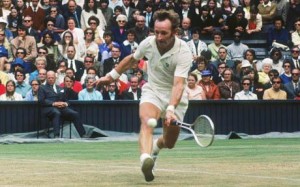
Rod Laver was the greatest tennis player of his era and some believe the best of all-time.
A new series for a new year, and this time we take a look at the men who have left an indelible mark on tennis. This companion piece to ‘Queens of the Court’ begins with possibly the greatest of the ‘Great Men of Tennis.’
It is the name that—eventually—no one argues about. In the debate about which man is the greatest of all time, Rod Laver is invariably the yardstick.
Even those who never saw him play, who have only heard tell of his achievements, bracket him with Pete Sampras and Roger Federer, with Don Budge and Pancho Gonzalez, with Bill Tilden and Jack Kramer.
Were it not for the five-year hiatus before the arrival of the Open era, most believe that Laver would have put the big “GOAT” question beyond argument. For if he had remained an amateur and so been allowed to play in the 21 Grand Slams between 1963 and the Australian Open in January 1968, who knows what Slam target Federer might yet have to reach?
In the years either side of that five-year “black hole,” Laver notched up 11 singles titles. He was in his prime, reaching his full potential.
Had he won just half of the Slams available to the amateur tour, he could have exceeded 20 titles, and there is every reason to think he would have done just that.
Laver’s chief contenders during his golden decade were both Australian and both formidable. Roy Emerson took the amateur route in 1963, and Ken Rosewall pursued a professional career with Laver.
While the former won their first two Slam finals in 1961, Laver took revenge the next year by beating Emerson in three Slam finals—and took the fourth Slam of the year from Marty Mulligan for good measure.
Against Rosewall, it was a similar story. In the first couple of years of their professional tour rivalry, Rosewall had the upper hand. By 1964, the balance had switched, and Laver won 15 of their 19 matches.
For good measure, Laver also beat another of the era’s greats, Gonzalez, in one of the most prestigious events of the year, the U.S. Pro Championships.
Modest beginnings
Rodney George Laver was born Aug. 9, 1938. The date is interesting because precisely one month later, Budge became the first man to win the complete Grand Slam.
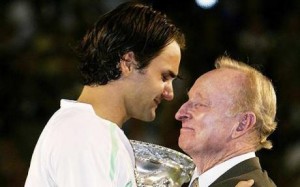
Laver and Roger Federer not only share tennis greatness, they also share birth months as their birthdates are just one day apart. Also celebrating a birthday during that same week is fellow superstar Pete Sampras.
(In another quirk of timing, Laver and his “GOAT” rivals, Federer and Sampras, all have birthdays in a four-day period: the ninth, eighth, and 12th, respectively.)
Laver, the youngest of four children, was raised on his parents’ ranch. He was a small, not overly healthy boy who began playing tennis at six on a court his father had built at their ranch. The Lavers were tennis fans, and his mother could play: She soon had all the children taking part in their local tournaments.
At 15, Laver missed two months from school with jaundice and, feeling left behind in his studies, decided to get a job and work at his tennis. His parents agreed.
Even though Laver remained small—he grew to just 5’8”—he developed great strength and speed, and was soon spotted by coach Harry Hopman (after whom the Hopman Cup is named). It was Hopman who christened the left-hander “the rocket,” not because of his speed, but for his determination and work ethic.
At 17, Laver took part in his first international tour, winning the U.S. Junior Championship. By 20, he had helped Australia beat the U.S.A. to win the Davis Cup. And at 21, he won his first major senior event, the Australian Championship—his first Slam.
Check out the Best Sports Card Investments in 2021
Big Year No. 1: Amateur, 1962
The Laver catalogue of achievements is so vast, it helps to turn the spotlight on key moments that allow the statistics to speak for themselves.
The first phase of Laver’s career began with that U.S. Junior title in 1956 and ended with the final year of his amateur status in 1962.
During that period, he won 54 titles. Six of them were Grand Slams, and he was runner-up in five more Slams.
In 1962 alone, he matched Budge’s achievement of the complete Grand Slam.
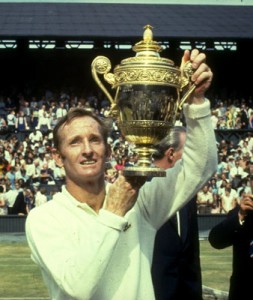
Laver won Wimbledon four times and claimed the season Grand Slam twice.
He won 22 tournaments on three different surfaces, ranging from hard in Venezuela, to clay in Houston, to grass in England.
From the end of March until the end of the U.S. Open, he played every single week: 16 tournaments, three Slams.
And this was during the amateur era when players paid their own way and made their own travel and boarding arrangements.
A modest man
It was not until he won his first title at Wimbledon that Laver felt he had proved himself: “I was looked on as a bit of a hacker…there was still a lot to prove and it was not until I won Wimbledon that I felt I could look people in the eye.”
That was in 1961. He won Wimbledon again in 1962, losing just one set along the way.
With the full Grand Slam to his name, Laver was now ready to earn a decent living from his achievements and turned professional.
It had taken him a while to get his game into such match-winning order. Laver had an aggressive, attacking style with powerful ground strokes and lightning-quick movement. But controlling his game had not come easily.
His sometimes extravagant shot-making was one of the reasons he lost those early finals. “I used to like to give it a bit of a nudge,” he has since admitted, with his usual understatement.
He had to learn how to play percentage tennis, to use tactics as well as full-blooded ball-striking.
Technically, Laver was outstanding, with superb timing and great disguise on his swinging left-handed serve.
His wristy ground-strokes on both sides were hit with topspin, quite an innovation in the 1960s, as was the attacking topspin lob.
At the net, too, he was formidable, economic, and deadly in his execution. And his huge left forearm, wielding power and speed, became the stuff of legend.
With his skills, power, and control honed to perfection, he was able to take on all-comers.
Big Year No. 2: Professional, 1967
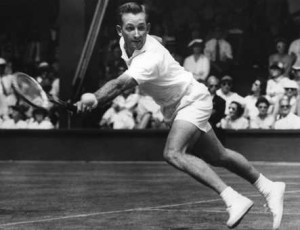
Laver won 10 Grand Slam titles despite being ineligible to compete in the tournaments for five years after turning pro following the 1962 season.
The second phase of Laver’s career marked his segregation from the amateur tour: 1963 to 1967. Definitive statistics are a little harder to come by for this period, but what is certain is that Laver won a minimum of 47 titles—some sources put the figure as high as 69.
More significant, and undisputed, is that he reached the final of all three major professional tournaments every year from 1964 to 1967 inclusive: the U.S., Wembley, and French Pro Championships.
In 1967 alone, Laver won 19 titles, including not only the three Pro Championships but also the only professional tournament staged on Wimbledon’s Centre Court until the Open era. He beat Rosewall in the final 6–2, 6–2, 12–10.
In those pre-tie-break days, matches could be very long duels indeed. Laver’s win over Gonzalez in the 1967 U.S. Professional Indoor Championships final went to 7-5, 14-16, 7-5, 6-2. His win over Rosewall in Paris a few weeks later was 6-0, 10-8, 10-8.
Laver won on wood, on clay, and on grass.
He won indoors and outdoors.
Between the beginning of March and the beginning of May, he travelled from Puerto Rico to Miami, Boston, Montreal, Paris, and back to San Diego.
He was renowned for his fitness, and the arduous professional tour certainly needed it.
A modest player
Many claim that it was probably easier to win the Grand Slam in the pre-Open era than it is today. There were fewer players on the Tour and tennis did not have the same depth. Laver is the first to admit that the pressures on players are very different now.
“Coming into the U.S. Open, the importance of it all wasn’t that big because tennis itself wasn’t as popular. There were only 10 to 15 reporters. Everything a player does now is put under a microscope…it is so much more popular, there’s so much more money, attention—everything is bigger.”
And that applies to the rewards, too, but Laver is less distracted by the money in today’s game than by the tennis.
“The money’s one thing, but today’s game is much more physical than when we played. The ball is hit so much harder, the players generate so much speed and spin. I’d have to play differently if I was out there today.”
It’s entirely in character for the great Laver to focus on the achievements of, and pressures on, today’s players rather than his own. But the pressures under which he played were different.
In the early days, the rewards were slim, the travelling constant. There was no money for entourages to organise training, transport, physio, and the rest.
Laver drove himself to his Slam finals, had his own rackets strung, donned spiked shoes when the grass in that 1969 U.S. Open final was waterlogged.
The rallies in his matches may have been quicker but, with no tie-breaks, the matches themselves could be just as long, and more were the best of five sets.
There were no chairs at the change of ends, no roofs if the conditions got too hot, no postponements if a storm blew up.
Laver says of the current tour: “It’s tough out there today.”
It was tough out there for Laver, too, but he’d be the last to admit it.
Big Year No. 3: Open, 1969
Laver’s final phase opened in 1968 and closed with his retirement in 1976.
In Slam terms, it started slowly, with just the Wimbledon title in 1968, though he also won the U.S. and the French Pro Championships, taking 12 titles in the year.
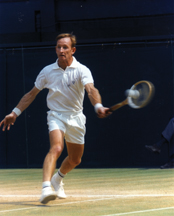
Laver won his second season Grand Slam in 1969, but never won another major.
But 1969 was the record-breaker. Laver became the only man to win a complete Slam in the Open era, and the only player, man or woman, to win two complete Slams.
He beat a different man in each final: Andres Gimeno, John Newcombe, Tony Roche, and Rosewall.
He had also met Roche in the semis of the Australian Open in one of the most gruelling matches ever played. It took 90 games, a break to take a shower after three sets, and, it is said, cabbage leaves inside his hat for relief from the heat. The final score: 7-5, 22-20, 9-11, 1-6, 6-3.
Appropriately, Laver became the first player to break the US $100,000 earnings barrier in a year.
A far-from-modest conclusion
During this final period, Laver went on to win at least 40 tournaments, according to the ATP. In practice, it was nearer 76 because he was still contracted to play in the National Tennis League before it merged with World Championship Tennis (the ATP’s forerunner).
He won the new Tennis Champions Classic, now the World Tour Finals, in its first year, and defended the title in 1971.
What gave him particular pleasure just as he approached retirement was to rejoin, after an 11-year gap, the Davis Cup squad. (Professionals had been banned from participating until 1973.)
He won all his rubbers in the semi-final and final ties, and Australia beat the U.S.A. for the title. It was the fifth time he’d played for his country, and the fifth time he’d been on the winning team.
In all, his 23-year career yielded at least 183 titles—some say it’s 199. Either way, it gives Federer’s 65 and Sampras’s 64 some perspective.
He remains an informed and enthusiastic follower of the game, despite the setbacks of a stroke, knee surgery, and a new hip.
In 2000, the Australian Open authorities renamed Melbourne Park’s centre court in his honor: It could not have happened to a more deserving man.
Laver was never the handsome one, nor the charismatic one: and not the attention-seeking type. But he was the one whose tennis rocketed to the greatest heights.
“For something like that to happen in your lifetime…it’s very special and I consider it to be the crowning moment of my career. You only have to look up at the name on the magnificent stadium court at Melbourne Park to realize how truly privileged I am.”
The privilege, surely, is ours.
For a flavor of Laver, take a look at highlights from the Wimbledon semi-final in that Slam year of 1969, made doubly delightful by the tennis of Arthur Ashe.
My second read and it truly is as good or better the second time around!! How appropriate, at the conclusion of a Great Australian Open to offer this article this great Australian player who led a legion of great Australians during the era when they reigned supreme! Laver was special – the father of the modern game and his respect for the game and his admiration for current players is inspirational. Great piece!!
Many thanks indeed, Joan.
I was too young to truly appreciate either his tennis or his contribution to the game at the time. The older I've become, the more that has changed.
It's great to see some of the current players recognising his stature, and able to embrace his place in tennis's history.
During the 50's when I was in high school I played a little pickup tennis…therefore I walked into Stowe Stadium in Kalamazoo during the US Junior Amateur tournament and sat down… there was a floppy hatted left hander just beating the hell out of his opponent..of course it was Rod Laver and I cherish that moment in my life very much.
I found some good information in your site and bookmarked to visit again . Thanks.
We are all join together in the ground. Tans ball match was going when we entered in the ground. We have seen much talent, which can be highly show some talent on the best position. They want to express to the odious in the ground. There were many fans, who want to sport as a fan. I really do much enjoy on this match.
I am see the great contents and step by step read really nice information.I am gather this concepts and more information. It's helpful for me my friend. Also great blog here with all of the valuable information you have.
Roger Federer is love. he is still playing like a young champ.